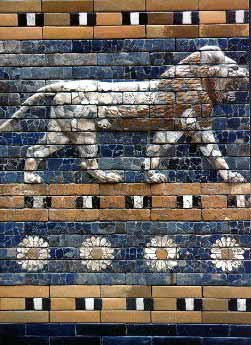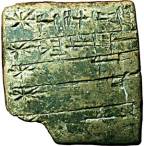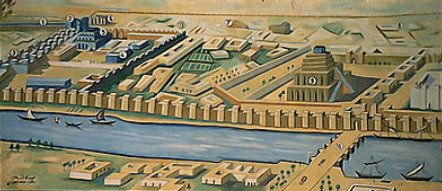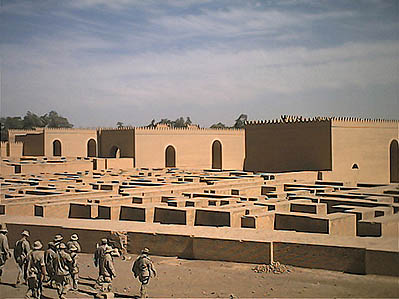Babylon
Babylon is the later name given to Babel which means Confusion. It was the capital city of Babylonia in Mesopotamia (in contemporary Iraq, about 70 mi/110 km south of Baghdad). The name is the Greek form of Babel, which is derived in turn from the Semitic form bab-Illu, meaning "The Gate of God". This Semitic word is a translation of the Sumerian Kadmirra.
The earliest mention of Babylon is in a dated tablet of the reign of Sargon of Akkad (24th century BC short chr.), who made it the capital of his empire. Over the years its power and population waned. For centuries it was just another provincial town, until it became the capital of Hammurabi's empire (18th century BC) From this time onward it continued to be the capital of Babylonia.
Detail of Istar Gate, Babylon
 The city itself was built upon the Euphrates, divided in equal parts among its left and right banks with steep embankments built to contain the river’s seasonal floods. Babylon gradually grew in extent and grandeur, but in process of time it became subject to Assyria. It rebelled against the Assyrian rule under Mushezib-Marduk and again under Shamash-shum-ukin but was besieged and taken over by Sennacherib and Assurbanipal (Kandalanu) again.
The city itself was built upon the Euphrates, divided in equal parts among its left and right banks with steep embankments built to contain the river’s seasonal floods. Babylon gradually grew in extent and grandeur, but in process of time it became subject to Assyria. It rebelled against the Assyrian rule under Mushezib-Marduk and again under Shamash-shum-ukin but was besieged and taken over by Sennacherib and Assurbanipal (Kandalanu) again.
During the reign of Sennacherib, Babylon underwent a constant state of revolt, which was only suppressed by the complete destruction of the capital. In 689 BC its walls, temples and palaces were razed to the ground and the rubbish thrown into the Arakhtu, the canal which bordered the earlier Babylon on the south. This act shocked the religious conscience of Mesopotamia; the subsequent murder of Sennacherib was held to be an expiation of it, and his successor Esarhaddon hastened to rebuild the old city, to receive there his crown, and make it his residence during part of the year. On his death Babylonia was left to his elder son Shamash-shum-ukin, who eventually headed a revolt against his brother Assur-bani-pal of Assyria.
Once again Babylon was besieged by the Assyrians and starved into surrender. Assur-bani-pal (or Assurbanipal) purified the city and celebrated a "service of reconciliation", but did not venture to "take the hands" of Bel. In the subsequent overthrow of the Assyrian empire the Babylonians saw another example of divine vengeance.
 On the fall of Nineveh (612 BC) Babylon had thrown off the Assyrian yoke, and became the capital of the growing Babylonian empire.
On the fall of Nineveh (612 BC) Babylon had thrown off the Assyrian yoke, and became the capital of the growing Babylonian empire.
With the recovery of Babylonian independence under Nabopolassar a new era of architectural activity set in, and his son Nebuchadnezzar made Babylon one of the wonders of the ancient world.
It was under the rule of king Nebuchadnezzar (605 BC-562 BC) that Babylon had become one of the most splendid cities of the ancient world. Nebuchadnezzar ordered the complete reconstruction of the imperial grounds, including rebuilding the Etemenanki and the construction of the Ishtar Gate, the most spectacular of eight that ringed the perimeter of Babylon. The Ishtar Gate survives today in the Pergamon Museum in Berlin. Nebuchadnezzar is also credited with the construction of the Hanging Gardens of Babylon (one of the seven wonders of the ancient world) which he is said to have had built for his homesick wife Amyitis. Whether the gardens did exist is a matter of dispute. Although excavations by German archaeologist Robert Koldewey are thought to reveal its foundations, many historians disagree about the location, and some believe it may have been confused with gardens in Nineveh.
After passing through various vicissitudes the city was occupied in 538 BC by Cyrus the Great, king of Persia, who issued a decree permitting the Jews to return to their own land (Ezra 1). Under Cyrus, and his heir Darius I, Babylon became a center of learning and scientific advancement. Babylonian scholars completed maps of constellations, and created the foundations of modern astronomy and mathematics. However, under the reign of Darius III, Babylon began to stagnate.

In 331 BC The Persian king Darius III was defeated by the forces of the Macedonian ruler Alexander the Great at the battle of Gaugamela, and in October Babylon saw its invasion and occupation. A native accounting of this invasion notes a ruling by Alexander not to enter the homes of its inhabitants.
Under Alexander, Babylon again flourished as a center of learning and commerce. But, after Alexander’s mysterious death in 323 BC in the palace of Nebuchadnezzar, his empire was divided amongst the generals, and decades of fighting soon began, with Babylon once again caught in the middle.
The constant turmoil virtually emptied the city of Babylon. A tablet dated 275 BC states that the inhabitants of Babylon were transported to Seleucia, where a palace was built as well as a temple to which the ancient name of E-Saggila was given. With this event the history of Babylon comes practically to an end, though more than a century later it was found that sacrifices were still performed in its old sanctuary. By 141 BC, when the Parthian Empire took over the region, Babylon was in complete desolation and obscurity.
Historical knowledge of Babylon's topography is derived from the classical writers, the inscriptions of Nebuchadnezzar, and the excavations of the Deutsche Orientgesellschaft, which were begun in 1899. The topography is necessarily that of the Babylon of Nebuchadrezzar; the older Babylon which was destroyed by Sennacherib having left few, if any, traces behind.
Most of the existing remains lie on the east bank of the Euphrates, the principal being three vast mounds, the Babil to the north, the Qasr or "Palace" (also known as the Mujelliba) in the centre, and the Ishgn "Amran ibn" All, with the outlying spur of the Jumjuma, to the south. Eastward of these come the Ishgn el-Aswador "Black Mound" and three lines of rampart, one of which encloses the Babil mound on the N. and E. sides, while a third forms a triangle with the S.E. angle of the other two. W. of the Euphrates are other ramparts and the remains of the ancient Borsippa. We learn from Herodotus and Ctesias that the city was built on both sides of the river in the form of a square, and enclosed within a double row of lofty walls to which Ctesias adds a third. Ctesias makes the outermost wall 360 stades (42 miles/68 km) in circumference, while according to Herodotus it measured 480 stades (56 miles/90 km), which would include an area of about 520 km² (approx. 200 square miles).
The estimate of Ctesias is essentially the same as that of Q. Curtius (v. I. 26), 368 stades, and Clitarchus (ap. Diod. Sic. ii. 7), 365 stades; Strabo (xvi. 1. 5) makes it 385 stades. But even the estimate of Ctesias, assuming the stade to be its usual length, would imply an area of about 260 km² (100 square miles). According to Herodotus the width of the walls was 24 m (80 ft).
 US Marines at rebuilt ruins of Babylon |
Saddam Hussein installed a huge portrait of himself and Nebuchadnezzar at the entrance to the ruins. He also had part of the ruins rebuilt, to the dismay of archaeologists, with his name inscribed in an imitation of Nebuchadnezzar, on many bricks used. One frequent inscription reads, "This was built by Saddam Hussein, son of Nebuchadnezzar, to glorify Iraq". This was in relation to the ziggurat at Ur with its each individual brick stamped with the name of, " Ur-Nammu, king of Ur, who built the temple of Nanna". The bricks became sought after collectors' items after the fall of Saddam, and the ruins are being restored to their original state.
US forces have occupied the site for some time and have caused damage to the archaeological record. In a report of the British Museum's Near East department, Dr. John Curtis describes how parts of the archaeological site were levelled to create a landing area for helicopters, and parking lots for heavy vehicles. Curtis wrote that the occupation forces
"caused substantial damage to the Ishtar Gate, one of the most famous monuments from antiquity [...] US military vehicles crushed 2,600-year-old brick pavements, archaeological fragments were scattered across the site, more than 12 trenches were driven into ancient deposits and military earth-moving projects contaminated the site for future generations of scientists [...] Add to all that the damage caused to nine of the moulded brick figures of dragons in the Ishtar Gate by people trying to remove the bricks from the wall."
Click here to go back to the Middle East Page!
This article is licensed under the GNU Free Documentation License. It uses material from the Wikipedia article "Babylon".